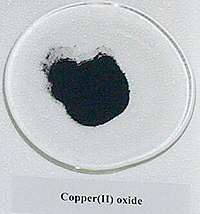Copper(II) oxide
 |
|
 |
|
 |
|
| Names | |
|---|---|
|
IUPAC name
Copper(II) oxide
|
|
| Other names
Cupric oxide
|
|
| Identifiers | |
|
1317-38-0 |
|
| 3D model (Jmol) |
Interactive image Interactive image |
| ChEBI |
CHEBI:75955 |
| ChEMBL |
ChEMBL1909057 |
| ChemSpider |
144499 |
| ECHA InfoCard | 100.013.882 |
| PubChem | 14829 |
| RTECS number | GL7900000 |
| UNII |
V1XJQ704R4 |
|
|
|
|
| Properties | |
| CuO | |
| Molar mass | 79.545 g/mol |
| Appearance | black to brown powder |
| Density | 6.315 g/cm3 |
| Melting point | 1,326 °C (2,419 °F; 1,599 K) |
| Boiling point | 2,000 °C (3,630 °F; 2,270 K) |
| insoluble | |
| Solubility | soluble in ammonium chloride, potassium cyanide insoluble in alcohol, ammonium hydroxide, ammonium carbonate |
| Band gap | 1.2 eV |
| +238.9·10−6 cm3/mol | |
|
Refractive index (nD)
|
2.63 |
| Structure | |
| monoclinic, mS8 | |
| C2/c, #15 | |
|
a = 4.6837, b = 3.4226, c = 5.1288
α = 90°, β = 99.54°, γ = 90°
|
|
| Thermochemistry | |
|
Std molar
entropy (S |
43 J·mol−1·K−1 |
|
Std enthalpy of
formation (ΔfH |
−156 kJ·mol−1 |
| Hazards | |
| Safety data sheet | Fischer Scientific |
|
EU classification (DSD)
|
Harmful (Xn) Dangerous for the environment (N) |
| NFPA 704 | |
| Flash point | Non-flammable |
| US health exposure limits (NIOSH): | |
|
PEL (Permissible)
|
TWA 1 mg/m3 (as Cu) |
|
REL (Recommended)
|
TWA 1 mg/m3 (as Cu) |
|
IDLH (Immediate danger)
|
TWA 100 mg/m3 (as Cu) |
| Related compounds | |
|
Other anions
|
Copper(II) sulfide |
|
Other cations
|
Nickel(II) oxide Zinc oxide |
|
Related compounds
|
Copper(I) oxide |
|
Except where otherwise noted, data are given for materials in their standard state (at 25 °C [77 °F], 100 kPa).
|
|
|
|
|
| Infobox references | |
Copper(II) oxide or cupric oxide is the inorganic compound with the formula CuO. A black solid, it is one of the two stable oxides of copper, the other being Cu2O or cuprous oxide. As a mineral, it is known as tenorite and paramelaconite. It is a product of copper mining and the precursor to many other copper-containing products and chemical compounds.
It is produced on a large scale by pyrometallurgy used to extract copper from ores. The ores are treated with an aqueous mixture of ammonium carbonate, ammonia, and oxygen to give copper(I) and copper(II) ammine complexes, which are extracted from the solids. These complexes are decomposed with steam to give CuO.
It can be formed by heating copper in air at around 300 - 800°C:
For laboratory uses, pure copper(II) oxide is better prepared by heating copper(II) nitrate, copper(II) hydroxide or copper(II) carbonate:
Copper(II) oxide is an amphoteric oxide, so it dissolves in mineral acids such as hydrochloric acid, sulfuric acid or nitric acid to give the corresponding copper(II) salts:
It reacts with concentrated alkali to form the corresponding cuprate salts:
It can also be reduced to copper metal using hydrogen, carbon monoxide, or carbon:
When cupric oxide is substituted for iron oxide in thermite the resulting mixture is a low explosive, not an incendiary.
Copper(II) oxide belongs to the monoclinic crystal system. The copper atom is coordinated by 4 oxygen atoms in an approximately square planar configuration.
...
Wikipedia

